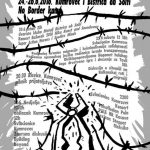Slovenian fence on its border with Croatia could destroy important historical heritage.
The construction of the border fence between Slovenia and Croatia, in order to prevent alleged influx of migrants from the Middle East, has already caused a lot of problems for both people living in the border area and animals caught in the barbed wire. However, it seem that historical heritage could be the next victim, reports Novi List on March 6, 2017.
Damjan Kovač, a thirty-five-year old artist from Prezid, warns that the latest moves done by the Slovenian authorities with regards to the construction of a panel fence along the border could cause a potential disaster for cultural heritage. The fence around the Prezid area is being constructed right next to an ancient Roman wall, which could destroy the protected cultural monument, the defensive wall built two thousand years ago in order to stop various barbarian tribes from coming into the Roman Empire.
“Instead of this historically very significant wall being preserved, restored and offered not only as an interesting piece of history, but also as a potential tourist attraction, we are allowing a panel fence to be constructed on it and right next to it, which devalues a part of the history when we were part of Europe, part of the great Roman Empire, and our neighbours were not. On the entire visible part of the border, Slovenian workers are putting up a fence which ‘erases’ the wall, and it is quite possible that all the drilling and digging for the fence will permanently damage it. Also, the fence is putting at risk a very important historical site, a village from the period of the Hallstatt culture, built in about 500 BC”, said Kovač, adding that the latest move by Slovenian authorities was causing discontent among the people on both sides of the border.
“Until now, the Roman wall was connecting us because it was a protected cultural monument on both sides of the border. In addition, in the last two centuries, despite numerous wars in the area, no one ever touched the wall, and now they are putting a fence on it. Why are they doing it since there are no migrants here? It is interesting that on the Slovenian side there have already been reactions coming from representatives of various cultural and ecological associations, as well as articles published by their media. On our side of the border, few people are interested in this, which just shows our attitude towards culture and history, as well as to the Gorski Kotar region”, said Kovač, who has decided to change that.
“I first informed the Culture Ministry and one representative of the ministry came here and saw what was going on. We spoke with Slovenian workers who are putting up the fence and asked them if they knew that the Roman wall was here. They responded in the affirmative, but continued with the construction activities. It is obvious that our state institutions do not know what is going on, since some of them reacted only after I told them about it. I think that Croatia should as soon as possible get the Ministry of Culture, if nothing else, to supervise the construction of the fence and demand from the Slovenians not to construct it on the wall itself”, said Kovač.









